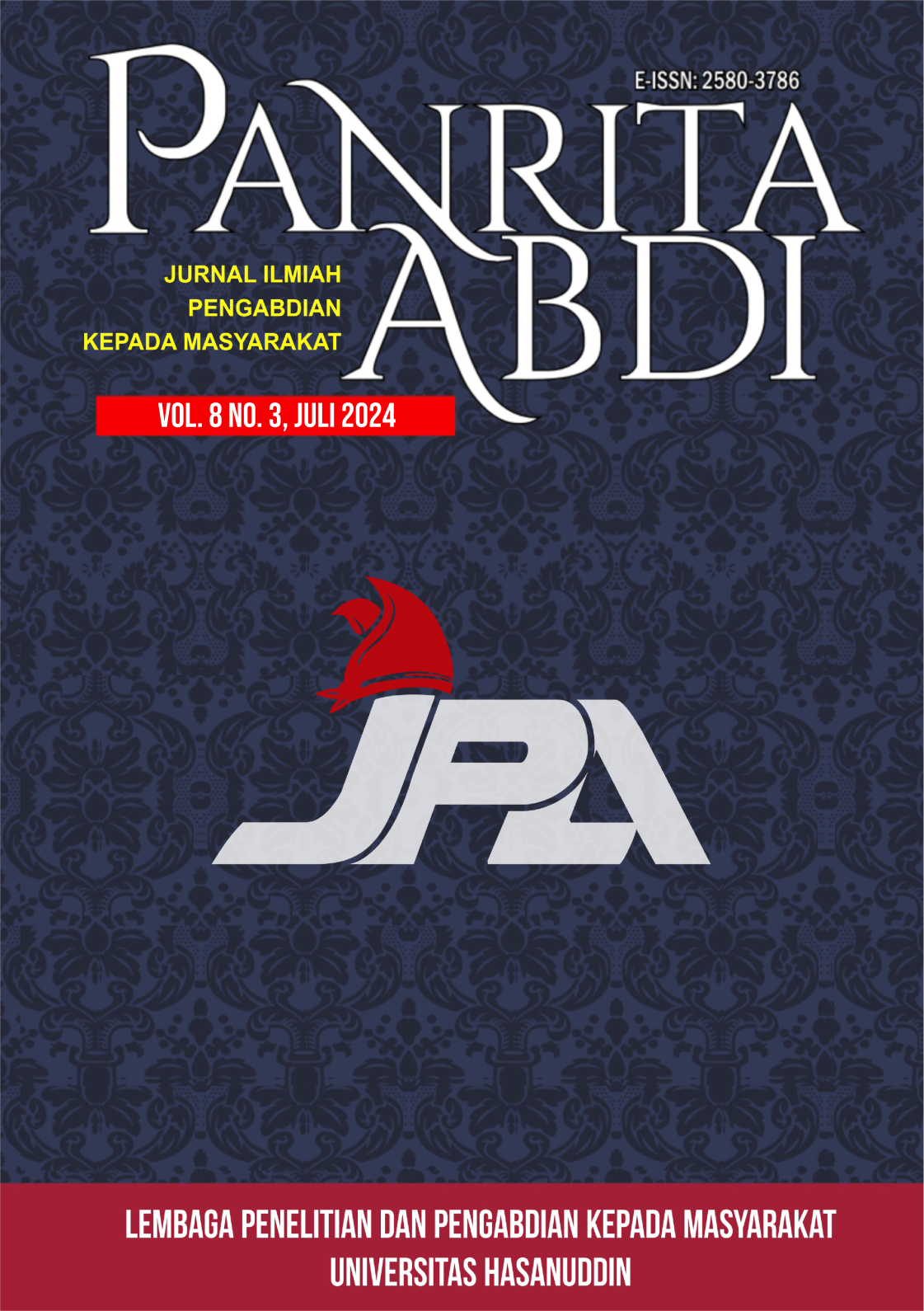PEMBERDAYAAN SEKOLAH SIAGA BENCANA MELALUI SIMULASI DAN VIDEO KESIAPSIAGAAN DI SDN 63 KOTA TERNATE
DOI:
https://doi.org/10.20956/pa.v8i3.25182Keywords:
Earthquake, preparedness, simulationAbstract
Ternate is an area with active volcanoes, where the center of Ternate City is located on an island with an active volcano, namely Mount Gamalama. This condition indicates that Ternate City is at high risk of the threat of volcanic eruptions. One of the communities that is a priority for disaster management programs is schools. This is because schools can take an active role in improving knowledge and attitudes about disasters, emergency response plans, and their role in disaster mitigation. Therefore, one of the efforts made to increase preparedness in reducing disaster risk is through disaster preparedness training using simulation and video methods. This empowerment aims to provide knowledge to elementary school students regarding preparedness for volcanic eruptions and earthquakes. The activity methods used in this community service are earthquake simulations and videos on disaster preparedness for Mount Erupus. As a result of this activity, 90% of the 60 students experienced increased knowledge and increased experience directly related to being prepared to face volcanic eruptions and earthquakes. It is hoped that schools located at the foot of Mount Gamalama will add material about disaster preparedness to the elementary school curriculum, for example, in scout extracurricular activities. --- Ternate adalah salah satu daerah dengan gunung berapi aktif, dimana pusat Kota Ternate terletak di sebuah pulau dimana terdapat gunung berapi aktif, yaitu gunung Gamalama. Kondisi ini mengindikasikan bahwa Kota Ternate menjadi berisiko tinggi terhadap ancaman letusan gunung berapi. Salah satu komunitas yang menjadi prioritas program manajemen bencana adalah sekolah. Hal ini dikarenakan sekolah dapat mengambil peran aktif dalam memperbaiki pengatahuan dan sikap mengenai bencana, rencana tanggap darurat serta peran dalam mitigasi bencana. Oleh karena itu, salah satu upaya yang dilakukan dalam meningkatkan kesiapsiagaan dalam pengurangan risiko bencana adalah melalui pelatihan siaga bencana menggunakan metode simulasi dan video. Tujuan dari pemberdayaan ini adalah untuk memberikan pengetahuan kepada siswa sekolah dasar mengenai kesiapsiagaan menghadapi bencana gunung Meletus dan gempa bumi. Metode kegiatan yang digunakan dalam Pengabdian masyarakat ini adalah simulasi gempa bumi dan video kesiapsiagaan bencana gunung Meletus. Hasil dari kegiatan ini dari 60 siswa, 90% mengalami peningkatan pengetahuan dan bertambahnya pengalaman secara langsung terkait dengan siap siaga menghadapi bencana gunung Meletus dan gempa bumi. Diharapkan sekolah yang berada di bawah kaki gunung Gamalama perlu menambahkan materi tentang disaster preparedness ke dalam kurikulum sekolah dasar,misalnya dalam kegiatan ekstrakurikuler pramuka.Downloads
References
Badan Nasional Penanggulangan Bencana. (2012). Buku Saku Tanggap Tangguh Menghadapi Bencana. Jakarta. BNPB. In Buku Saku Tanggap Tangguh Menghadapi Bencana.
Brams, W. S. (2012). Teknik Mitigasi Gempabumi.pdf.
Hafsar, K., Khairunnisa, & Nugraha, A. H. (2022). Pengenalan Jasa Ekosistem Pesisir di Sekolah Menengah Atas Negeri 1 Kabupaten Bintan Introducing Coastal Ecosystem Services at Senior High School 1 Bintan Regency. Jurnal Panrita Abdi, 6(3), 539–547. http://journal.unhas.ac.id/index.php/panritaabdi
Idrus, F. N., Zuhriyah, L., & Suharsono, T. (2019). Comparison of simulation method and animation video on knowledge related to preparedness of elementary school students in Ternate, Indonesia. Indian Journal of Public Health Research and Development, 10(8), 2037–2041. https://doi.org/10.5958/0976-5506.2019.02154.5
Oktari, R. S., Shiwaku, K., Munadi, K., Syamsidik, & Shaw, R. (2018). Enhancing community resilience towards disaster: The contributing factors of school-community collaborative network in the tsunami affected area in Aceh. International Journal of Disaster Risk Reduction, 29(April 2017), 3–12. https://doi.org/10.1016/j.ijdrr.2017.07.009
Olson, D. K., Scheller, A., Larson, S., Lindeke, L., & Edwardson, S. (2010). Using gaming simulation to evaluate bioterrorism and emergency readiness education. Public Health Reports, 125(3), 468–477. https://doi.org/10.1177/003335491012500316
Syamila, A. I., Nurika, G., & Ridzkyanto, R. P. (2023). Sekolah Siaga Bencana: Peningkatan Pengetahuan dan Keterampilan Siswa dalam Upaya Mitigasi Bencana Gempa Bumi di SDN 1 Panji Lor Situbondo. Jurnal Panrita Abdi, 7(2), 390–397. http://journal.unhas.ac.id/index.php/panritaabdi
Terminology, U., & Reduction, D. R. (2009). Comment: In engineering terms, acceptable risk is also used to assess and define the structural and non-structural measures that are needed in order to reduce possible harm to people, property, services, and systems to a chosen tolerated level, according to t. Building, 2009, 1–13.
Tivener, K. A., & Gloe, D. S. (2015). The Effect of High-Fidelity Cardiopulmonary Resuscitation (CPR) Simulation on Athletic Training Student Knowledge, Confidence, Emotions, and Experiences. Athletic Training Education Journal, 10(2), 103–112. https://doi.org/10.4085/1002103
Tjahjono, B. (2020). Analysis of Aspects of Implementing Room Rehearsal Simulations and Disaster Emergency Handling Command Post Rehearsals at the BNPB Disaster Management Training Center. 2010.
Tomio, J., Sato, H., Matsuda, Y., Koga, T., & Mizumura, H. (2014). Household and Community Disaster Preparedness in Japanese Provincial City: A Population-Based Household Survey. Advances in Anthropology, 04(02), 68–77. https://doi.org/10.4236/aa.2014.42010
Unver, V., Basak, T., Tastan, S., Kok, G., Guvenc, G., Demirtas, A., Ayhan, H., Köse, G., Iyigun, E., & Tosune, N. (2018). Analysis of the effects of high-fidelity simulation on nursing students’ perceptions of their preparedness for disasters. International Emergency Nursing, 38(September 2017), 3–9. https://doi.org/10.1016/j.ienj.2018.03.002
World Health Organization and International Council of Nurses. (2009). ICN Framework of Disaster Nursing Competencies.
Downloads
Published
How to Cite
Issue
Section
License
Copyright (c) 2024 Fitriyanti Idrus, Amira Bin Seh Abubakar, Fitriyanti N Idrus, Muhlisa, Fadilah Abdullah

This work is licensed under a Creative Commons Attribution-NonCommercial-NoDerivatives 4.0 International License.



















